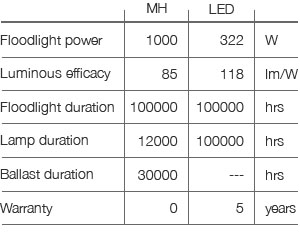
LED technology has recently undergone a great deal of development due to the investments made by lighting companies to overcome the deficiencies detected when it was first introduced. This fact, along with the international trend to create more energy-efficient airports leads us to broach the following questions: Is LED lighting really advantageous? Its use in public lighting is well known. However, what happens in airport aprons where the floodlights are installed at a height of 25 m? Do LED lamps provide enough luminous flux to compete with traditional metal halide lamps? Do the energy savings they provide offset their installation costs over their life cycle?
In order to answer these questions and obtain significant data, let’s take a real airport apron and design its lighting with metal halide floodlights and LED floodlights, taking into account in both cases the requirements laid down in Part 4, Document 9157 of the OACI Aerodrome Design Manual.
 The lights chosen have photometric symmetry, are manufactured by the same company and have the following technical characteristics (see attached table):
The lights chosen have photometric symmetry, are manufactured by the same company and have the following technical characteristics (see attached table):
After conducting a light study of the apron with both kinds of floodlights, we can deduce that:
- The installed total power output in the case of metal halide floodlights amounts to 176 kW. However, in the case of LED floodlights, said value totals 73.74 kW. If we additionally take into account the losses due to ballast, it turns out that a solution using LED lamps consumes 58% less. This installed power reduction entails direct savings in the airport’s electricity installation with regard to cabling, protection and power supplies.
- According to lamp, ballast and floodlight duration and taking into consideration that the airport operates 24 hours a day, it can be deduced that the metal halide lamps will be replaced every two or three years, while the LED floodlights will be replaced every 23 years.
- The luminous efficiency of LED floodlights is 38.8% greater than that of the metal halide floodlights.
- LED lamps light up immediately. The time lost while waiting for the lamp to reach the right temperature is therefore avoided.
Now then, if we look into the initial cost of LED floodlights as an investment as opposed to the cost of metal halide lamps and take into account maintenance and annual energy consumption as cash flows, we obtain an IRR of 19% and a NPV of $536,000, considering the price of US 30-year bonds as the required rate of return.
If LED lighting produces maintenance and energy consumption savings that lead to an investment with an IRR of 19% while providing the same levels of lighting, the question that arises is why hasn’t your airport installed LED apron lighting yet?


